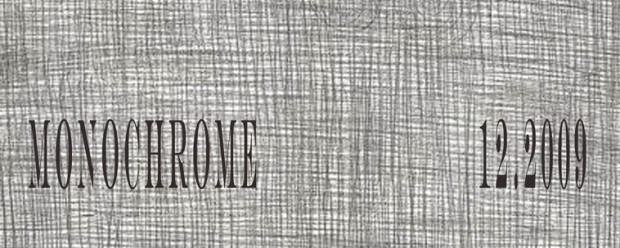Monochrome

Date: December 17th, 2009 – March 1st, 2010
Opening: December 17, 2009, 17:30
Curator: Barbara Benish
Artist: Leland Means (USA), Sabine Fassler-Luger (Rakousko), Vaclav Bis (ČR), Connie Zehr (USA), Shelby Graham (USA)
The theme is black and white, when artists look at reduction, as a means to get to an "essence" in their art. Starting with Austrian artist Fassler-Luger, who's small black and white drawings, entitled "snow" respond to the writer and Nobel Laureate Orhan Pamuk, this exhibition prepares us for the melancholia of winter. Her metal-point etchings speak to the raw earth of spring that lies ahead. Leland Means' small, pounded minimalist reliefs of lead, recall ancient tapa patterns. Vaclav Bis, Castelan at the castle of Jindrichuv Hradec, has secretly created graphic works for over 30 years. This is his first public exhibition. Connie Zehr, a professor of art in California for 30 years, has created delicate installations in monochrome, based on zen teachings. Her new photographs spin off of the larger site pieces. Shelby Graham, also based in California, explores the pain of war and political turmoil in her photo-collage "bomb" series.
The lead drawings are an intersection of drawing and sculpture. The material and the tooling and the action required to make the piece are from the world of sculpture, and the resulting object is a drawing.
These pieces are lead, pounded with several sized hammers between 20,000 and 40,000 times to form a delicate drawing approximately 0.030 centimeters thick.
The pieces are reminiscent in size and materials of “defixiones”, Greco Roman curse tablets; hammered sheets of lead upon which have been inscribed a plea to a particular god, often to request a curse upon an individual for some offense.
These curse tablets would often employ “voces mysticae” a language intelligible only to the sender and the spirit invoked. Similar to the images on the lead drawings, which have meaning only to the maker and those who find something of value in them.
These works are titled by their weight and can be purchased for the equivalent amount of gold as the piece weighs.
Artist Statement
Growing up in the United Stated during the Cold War, I had an image of “the bomb” or any bomb as an imaginary, shiny vessel. This vessel was to be feared and held in awe simultaneously. Years later, at the Atomic Bomb Museum in New Mexico, I photographed several kinds of bombs and missiles that fit my image of a shiny bomb. Many years later, in Nagasaki and Hiroshima, I visited a completely different kind of Atomic Bomb Museum, where I encountered the devastating effect bombs have on the human condition.
Both my parents were involved in World War II and were married in 1945 right after the war ended. Forty-five years later, my husband and I lived in Fukuoka, Japan from 1990–1992 and our first child was born there. My mother came to visit us in Fukuoka hoping to forget all the negative propaganda posters she witnessed during the war regarding Japan, but my father could not forget his fear and uneasiness and would not visit us during our stay in Japan. I have learned so much from the Japanese people and my experience of living in Japan and having a child there changed my life. I feel it is important to experience many cultures and views of representation. I am currently working on the series, “Living with Bombs” and the material is immeasurable.
Shelby Graham holds a MFA in photography from San Jose State University in California and has exhibited her work in the U.S. and Japan. Currently she is the Director of the Mary Porter Sesnon Art Gallery at the University of California Santa Cruz.
Contact information: sgraham@ucsc.edu.
Curatorial work: http://arts.ucsc.edu/sesnon/past_frameset.html

















